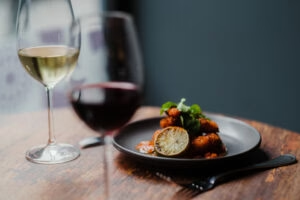Wine Pairings, Rules-of-Thumb

Recent COVID-19 figures forced the Irish Government into increasing national restrictions to Level 3. Hopefully, everybody will adhere to the said restrictions and flatten the curve, as we have done already this year.
In the said environment, perhaps people might think about ordering wine to enjoy at home, as community gatherings have been restricted. I want to write this post about wine pairings with foods, from a relaxed, please-yourself point of view.
When discussing wine pairings, the classic rule is if the meat is red, pick a red wine, and if the meat is white, pick a white wine.
Now I know that I have written extensively about wine pairings on this blog already. I delved into specific ones especially during COVID-19 lockdown earlier this year e.g. pairing with cakes, with seafood, with takeaway food and with cheese. As a general rule though, the above ‘rule’ whilst outdated, is a good place to base this article.
The said rule ‘worked’ when all we served was one type of fish, poached with lemon and olive oil, but these days we have more creativity with food preparations, cooking techniques and flavours.
What I’d like to do in this post is raise that old adage to a higher level but still keep to rules-of-thumb rather than strict guidelines. Sometimes, advice for wine pairings with food can be overly strict. My view is that you can drink whatever wine you like with whatever food you prefer.
My hope is that by taking on some of my suggested pairings you can then go ahead and break any rules as you see fit. At least you’ll have a base to do so.
Taste and Flavour, what’s the difference?
For centuries, people have been pairing local wine and food. It’s where the old saying “what grows together, goes together” came from – which remains a good rule-of-thumb still!
However, this is a fairly basic guideline and unfortunately, the wine industry doesn’t help the matter with technical tasting notes etc. This leads to people believing that pairings are intrinsically complex, when in fact, its just that people are different and perhaps don’t know where to start.
So let’s start here, by explaining the difference between taste and flavour. Tastes are structural in nature i.e. we can ‘feel’ them (sour, sweet, bitter, salty). Flavours (blackberry, honey, spice, butter etc) are more subjective and almost impossible to measure between people.
When it comes to pairing, if we were to favour one over the other, it would be best to prioritise pairing tastes first and then try to match flavours.
When it comes to pairing wine and food, if we were to favour one over the other, it would be best to prioritise pairing tastes first and then try to match flavours.
Click To Tweet
One could delve further into such pairing contributors such as flavour intensity and weight but I am not going to do so here. I’m sticking to my much referred to caveat from previous posts, that there is no precise right or wrong in food and wine pairings.
In fact, we could add another layer to the pairings’ mix – that of personal experience and culture. A topic for another post. Below I want to outline some basic wine pairings with food that you can use with confidence.

Ryan Devereux Photography
Pairing Grapes and Food
Wine is to be enjoyed and arming yourself with some basic knowledge opens up a whole new way to appreciate food. Try these:
Cabernet Sauvignon
The firm tannins in a cab sauv make it a perfect partner for juicy red meat. Specifically, Bordeaux blends are fabulous with steaks and lamb chops.
Champagne
Most sparkling wines are perfect with almost any food. Champagne, in particular though, is great with anything salty as the bubbles refresh the palate after each drink.
Chardonnay
It depends on the richness of the dish but in general Chardonnay is great with fatty fish (salmon) or fish in a rich sauce.
Dry Rosé
I like rosé with rich, cheesy dishes. I feel a dry rosé has the acidity of a white wine and the fruit character of a red.
Gamay
Enjoy a Beaujolais (gamay grape) with burgers and hot dogs (with all the dressings)
Grüner Veltliner
If there are plenty of fresh herbs in a dish, try a Grüner from Austria. It has a citrus and clover scent. (other options would be an Albariño from Spain and Vermentino from Italy).
Malbec
This grape is great for your BBQ meats. It is big and bold enough to drink with heavily spiced barbecue sauces. (Côtes-du-Rhône would work also).
Moscato d’Asti
This is wonderful with fruit desserts. It helps to emphasize the fruit in the dessert, rather than the sugar.
Pinot Grigio
Light seafood dishes seem to take on more flavour when matched with equally delicate white wines such as Pinot Grigio (an alternative to try would be a Chablis from France).
Pinot Noir
Recipes made with earthy ingredients like mushrooms and truffles taste great with a red like Pinot Noir, which is light-bodied but full of savoury depth.
Riesling (off-dry)
The slight sweetness of many Rieslings, help tame the heat of spicy Asian and Indian dishes. (alternatives would be Gewürztraminers and Vouvrays)
Sauvignon Blanc
This well-known and popular grape goes well with tangy foods. It’d be perfect with tart dressings and sauces. (alternatives would be Vinho Verde, from Portugal and Verdejo from Spain).
Syrah
When a meat is heavily seasoned, look for a red wine with lots of spicy notes. Syrah fits the bill. (alternative would be a Cabernet Franc from France).

The Winds of Change are Blowing
When it comes to fine wines and food, many sommeliers will suggest specific food pairings. However, I do believe they appreciate that in general, the most sacred of pairings are not immune to change.
Here’s a suggestion for you when pairing. Consider the wine as another condiment for the meal. Just like you might add salt or pepper to adjust the flavour – so too, pair a specific type of grape.
I have two taste caveats for you though – avoid serving white wine and game, and any dish that is sweeter than the dessert wine.
Another way of selecting what wine to pair with food is to look at how the food was prepared. Keep in mind the dominant flavour of the dish (e.g. a sauce) and match the wine to that! One other consideration might be how the food has been cooked e.g. grilled, roasted, fried, steamed etc.
Rules-of-Thumb
So, here are a few rules-of-thumb to keep in mind:
- Sweet foods will make a wine seem drier, stronger and less fruity.
- Foods that are highly acidic will make wines taste less sour, richer and more mellow
- Bitter flavours in food will bring out a wine’s bitterness.
- Salty foods will make your sweet wines taste sweeter.
- Fatty sauces need a wine with some weight.
- Tart and Tangy sauces on your meat cry out for a wine with a bit of zip.
- Vegetarian? If the main vegetable is “meaty,” then reach for red. For dainty or spring vegetable-based dishes a white will suffice.

Pair What Makes You Happy
If you’ve stayed with me reading to this point – thank you. I hope that I have explained some of the more basic pairing rules-of-thumb.
The main point I would like to leave you with is to follow the ‘rule’ that makes you the happiest. Your own palate will determine what the best wine pairings are. And if they don’t adhere to the classic rules – so what? There is no wrong or right pairing.
If you would like to order wine or discuss any pairings mentioned in this post please email me to james@greenacres.ie or ring us on +353 (0) 53 91 22975. Enjoy the the wine your with.
#maskingforafriend – Talk Soon – James.

The post Wine Pairings, Rules-of-Thumb appeared first on Green Acres.

